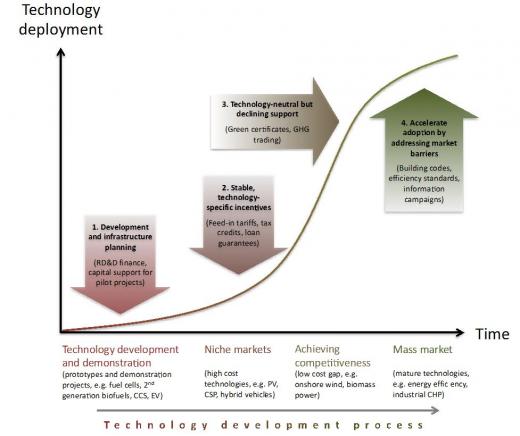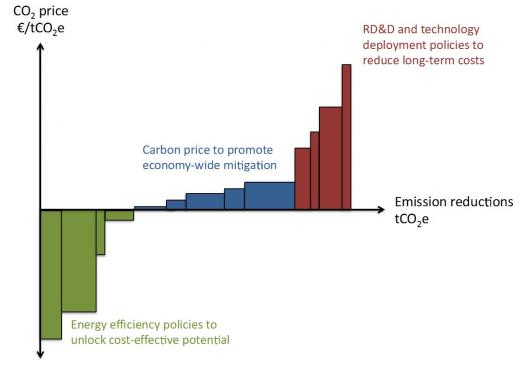Issues:
Sectors:
Keywords:
1. Does diversity in the European climate policy landscape make it inefficient?
European Union (EU) climate policy up to the year 2020 focuses on three main policy objectives: the greenhouse gas (GHG) 20% emission reduction target, the 20% energy efficiency target and the 20% renewable energy target. To meet each of these targets, EU wide policies and measures have been put in place. In some cases, such as the EU Emissions Trading System (ETS), these policies have been widely harmonised across the EU. In other cases, Member States (MS) have been able to choose and design related policies on their own, such as feed-in tariffs for renewable energy and net metering in Germany, or renewable portfolio standards in the United Kingdom (UK). Also subnational jurisdictions introduce relevant policies, such as building codes or subsidies for efficient buildings.
All these different policies interact and may reinforce each other, but they may also lead to inefficiencies. For example, CO2 emissions from electricity, heat and industry are addressed by the EU ETS, but also by policies supporting renewable energy deployment and measures to enhance energy efficiency.1 What does economic theory say about this interaction between climate policies?
2. Climate policy interaction: the theory
2.1. The case for a single climate mitigation policy
Standard economic theory says that to address one externality only one regulation is needed.2 To address climate change mitigation, it maintains that a carbon price, either through a tax or a cap-and-trade system, is the most cost-effective and welfare-maximizing way to encourage society to reduce CO2 emissions. It therefore questions the role of additional climate-related policies in achieving this goal.3 If for example one country or jurisdiction implements an emissions cap and at the same time a limitation on the amount of emissions allowed per unit of production in industry, then the combination of both policies leads either to redundancy or to higher costs. This is because both policies are trying to address the same market failure: the externality generated by the CO2 emissions.4
Under a cap-and-trade system like the EU ETS, the main drawback of adopting supplementary policies is that all the reductions delivered by these policies in the sectors covered by the ETS will just become part of the required abatement under the cap. They will therefore decrease the amount of reductions needed and lower the allowance prices. This in turn reduces the need for action in response to the price signal. This can make the cap-and-trade scheme less effective, particularly in a situation where the carbon price is already very low, as in the EU ETS in the years 2012-14. It may also create an imbalance between the cost of reductions achieved in the sectors covered by the ETS and of those in the other parts of the economy. If the carbon price is very low, it may even increase the risk of locking in high-emissions infrastructure.5 Thus, both the trading scheme and the supplementary policies need to be designed taking into account potential effects on the carbon price.
An example is given by the UK's introduction of a carbon tax for power generators, which aims to reduce CO2 emissions. These power generators are thus subject both to the tax on their emissions and to the EU ETS's cap on emissions. The tax may lead to greater emission reductions within the UK, but it will not affect the overall emissions level within the EU. Electricity generation will become comparatively more expensive in the UK, leading to competitiveness issues and emissions leakage.6
2.2. The case for supplementary policies beyond the carbon price
Despite these drawbacks, it has also been recognized that beyond the CO2 externality, there are strong economic, behavioural and organisational barriers to increasing energy efficiency or renewable energy use. These barriers, particularly those related to market failures, justify the adoption of additional policies to encourage technology adoption.7 In the case of several market failures, economic theory says that it is best to adopt as many policy instruments as the number of market failures involved, with each instrument addressing a different market failure.8
Hood9 argues that the core climate policy mix should be comprised of
- carbon pricing,
- energy efficiency policies that help to unlock additional cost-effective abatement potential, and
- technology deployment and research, development and demonstration (RD&D) policies that help realizing new mitigation options.
Figure 1 illustrates this core policy mix.
Diverse studies have found positive effects of such supplementary policies. Fischer and Newell10, for example, found that RD&D and deployment support policies reduce the cost of meeting an emissions cap considerably. Blyth et al.11, Eurelectric12 and Philibert13 reach similar findings for early technology (e.g. renewable energy, energy efficiency or carbon capture and storage) support policies.
Additional supplementary policies may also be needed to address other objectives, including:
- addressing leakage when the carbon price has incomplete coverage
- facilitating access to upfront finance
- preventing lock-in of high-emissions infrastructure
- minimizing abatement costs
- reducing policy uncertainty
- facilitating integration with wider policy priorities
- improving political acceptability.14
3. How to design appropriate climate policy packages that make a positive use of policy interactions?
The International Energy Agency (IEA)15 provides a simple guide about when – in the course of the technology development curve – to apply which policies so that mitigation costs can be minimized in the short and the long term. When a technology is still in development, policies should aim at financing research, development and demonstration through pilot projects. Technologies that are already mature but not yet competitive in the market need to be supported through technology-specific incentives, such as feed-in tariffs or tax credits. Technologies that are about to achieve competitiveness are best supported through technology-neutral policies such as green certificates or a carbon price. Finally, mature technologies may need to be supported by policies that address potential market barriers such as lack of information or misplaced incentives. This guide is adapted in Figure 2.

Figure 2: Schematic guide about when to apply which policies so that mitigation costs are minimized in the short and long term
Notes: CCS = carbon capture and storage; EV = electric vehicles; PV = photovoltaic; CSP = concentrated solar power; CHP = combined heat and power.
Further information about how climate policies interact in practice in Europe can be found in the Knowledge Package Interactions between Climate Policies: Examples from Europe.

